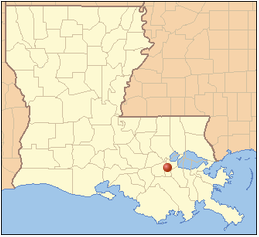| Home | Search | Emissions | Pollutants | About the Database |

Marathon Ashland Petroleum (3165), Garyville
LDEQ Accident Report
| Accident # | 128080 |
| State Police # | 10-07033 |
| Accident Date | 2010-12-09 |
| Report Date | 2010-12-16 |
| Follow-up Date | 0000-00-00 |
| Follow-up: | No |
Pollutants Released
| Pollutant | Duration | Point Source | Greenhouse Gas | Criteria Pollutant | Ozone forming chemical | Amount of Release |
| Sulfur Dioxide | 5 m | FCC Unit 205 | NO | YES | NO | 208.4 pounds |
| Highly Reactive Volatile Organic Compounds | 5 m | FCC Unit 205 | NO | NO | YES | 0.6 pounds |
| Volatile Organic Compounds (VOCs) | 5 m | FCC Unit 205 | NO | NO | YES | 3.4 pounds |
| Hydrogen Sulfide | 5 m | FCC Unit 205 | NO | NO | NO | 0.6 pounds |
| Nitric Oxide | 5 m | FCC Unit 205 | NO | YES | NO | 4.0 pounds |
| Carbon Monoxide | 5 m | FCC Unit 205 | NO | YES | NO | 3.4 pounds |
| Particulate Matter 10 | 5 m | FCC Unit 205 | NO | YES | NO | 0.3 pounds |
Accident Classified As: Below Reportable Quantity (BRQ)
Cause of Problem: Power Failure
Due to an unexpected loss of power to the control system of the Unit 25 FCCU. FCCU shut down as designed which resulted in less gas feed to the Unit 205 Coker. This decreased in feed caused the Coker Wet Gas Compressor Suction Drum to briefly exceed the maximum safe operating pressure of the drum which resulted in the Coker Wet Gas relieving tot he ground flare. There was no known offsite impacts resulting from this incident. The emissions from the FCCU shut down are permitted as part of the overall North Flare. Compressor spillback opened rapidly to compensate and a high pressure was reached on the suction drum. Pressure control valve opened to flare once pressure reached 21 psig.
Discharge Preventable - No Information Given
Unknown at this time. All aspects of this incident are currently under investigation. Once the Tap Root analysis is completed, all recommendations will be implemented in a timely manner. This investigation process is documented through the refinery's Knowledge Management System (KMS).
Notes/Remedial Actions
The FCCU was safely shut down and all other related unit feed rates were adjusted per the FCCU shutdown plan. The Coker Unit Wet Gas Compressor control system compensated for the increased suction pressure by increasing the compressor speed. All aspects of this incident are currently under investigation.

Connect With Us: